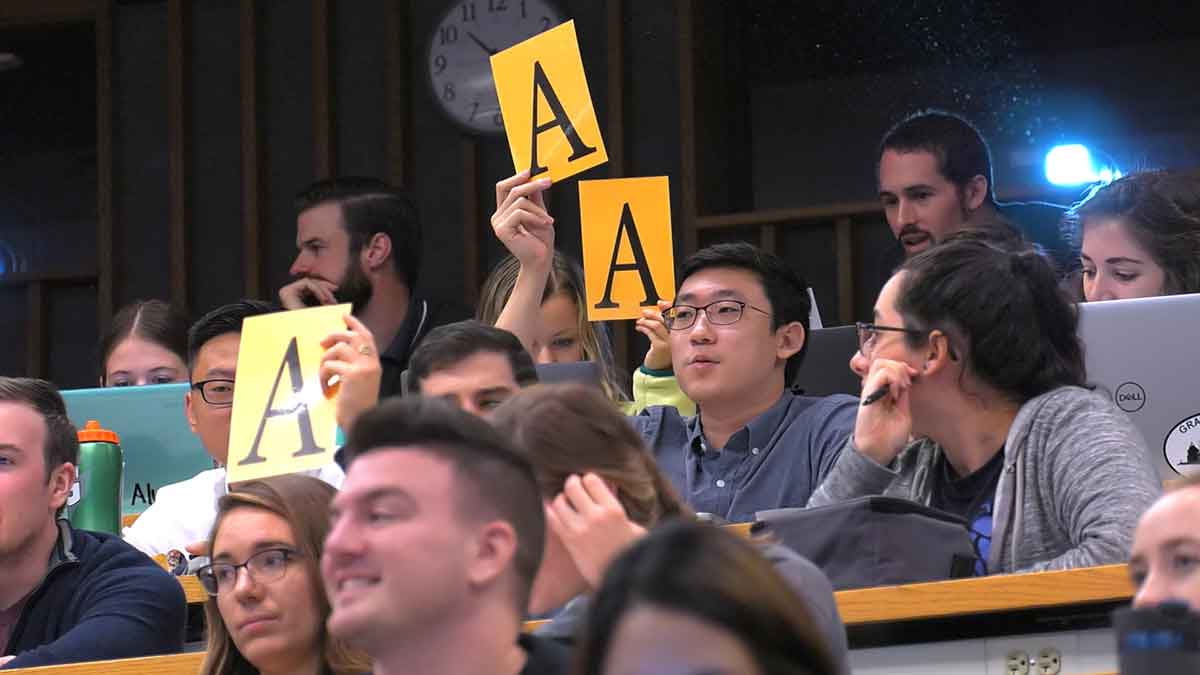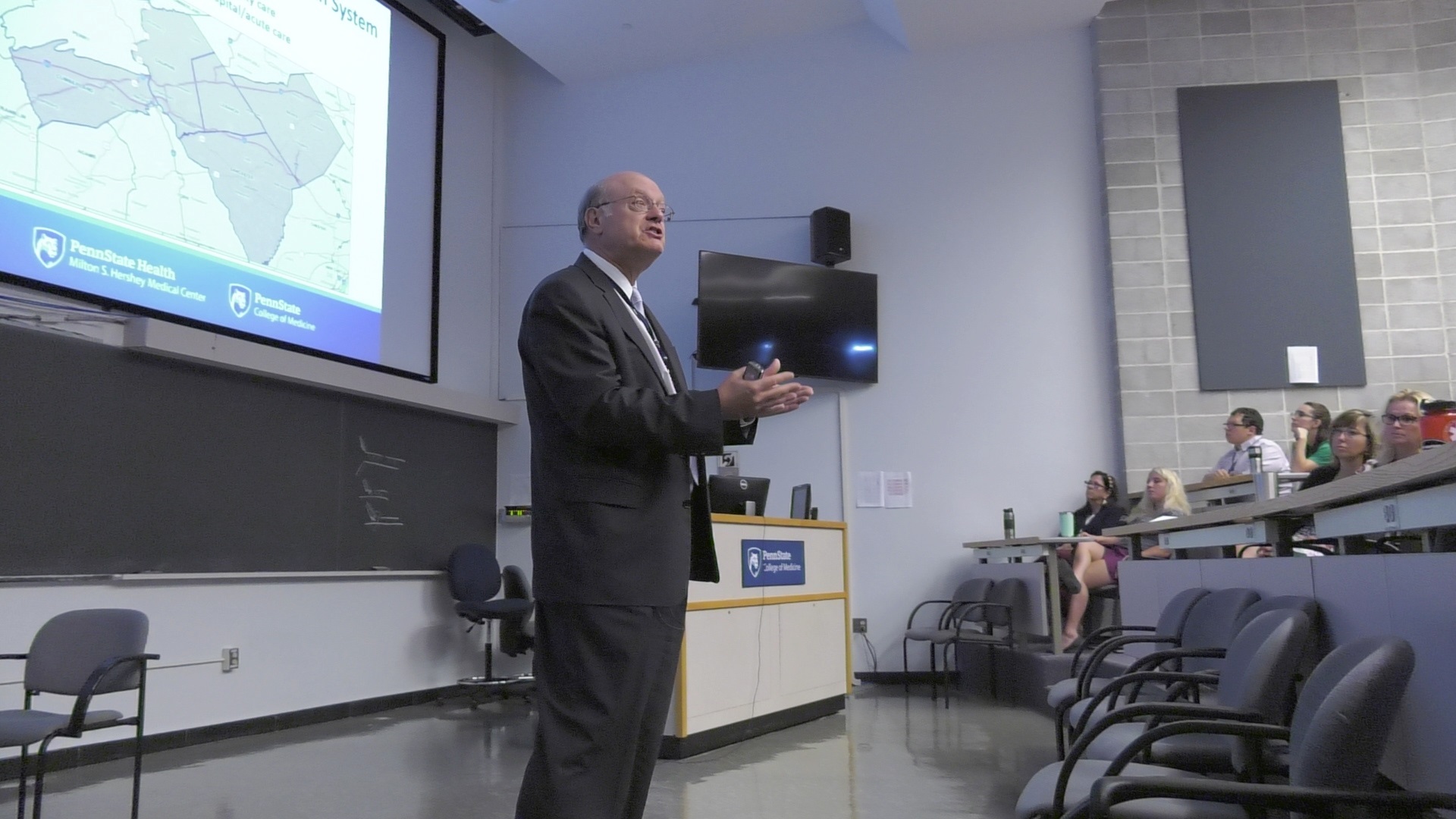The Big Picture: Science of health systems class prepares next generation of doctors

When Dennis Madden decided to become a doctor, he didn’t realize that practicing medicine in the 21st century would entail negotiating a health system that includes much more than treating patients.
“This generation of medical student is expected to do a lot more,” said the first-year Penn State College of Medicine student. “We’re expected to think socially, medically and globally, to be drivers of research and to think about the finances behind the health system, too.”
The challenge, Madden said, is overwhelming and exciting — a sentiment shared by many of the students who are in a College of Medicine class called Science of Health Systems, where they are studying ramifications of an emerging model of health system and how it will impact the way they will practice medicine.
The class is meant to prepare them to become something that their professor, Dr. Jed Gonzalo, associate dean of health systems education at the College of Medicine, calls a “system citizen.”
“Medical school really is focused on biomedical science, which is critically important, but we are also trying to develop learners who have a professional identity as being bigger than that,” he said. “It’s not just about the patient in front of you; it’s also about being an ambassador and advocate for the larger health system, which is a bit of a switch.”
The class stresses interactive learning, providing students with small-group discussion time, community projects that put them in touch with specific patient populations and dialogue with guest speakers.
The past five to seven years have seen a big shift in the health care dynamic in central Pennsylvania, Dr. Craig Hillemeier, dean of the College of Medicine and CEO of Penn State Health, told the students. He, like other senior leadership of Penn State Health, contributes to the design and delivery of the class.
“We are transitioning from a stand-alone academic medical center to a regional health system that is bringing care closer to where patients live,” Hillemeier said. For the past 50 years, Penn State Health Milton S. Hershey Medical Center was central Pennsylvania’s destination for specialized care, but in a shifting health care landscape, competition from academic medical centers in Pittsburgh, Philadelphia and Baltimore that are now merging or partnering with local community hospitals is forcing Penn State Health to change its model, he said.
Hillemeier talked to the students about today’s definition of a health system and why it must change to meet the goals of improving the health of the individual and the community’s population at a reduced cost.
“We spend almost twice as much for each individual in health care as any other developed country in the world, yet the life expectancy is higher in virtually any developed country than it is in the U.S.,” he said.
Students also learned about another shift that will impact how they practice medicine—the trend away from independent medical practices to ownership by a large health care system. This requires more standardization of how things are done and less autonomy as a provider. The question is how to provide care efficiently and with accessibility, Hillemeier said.
“A fundamental question is how to move health systems away from solely providing medical care to integrating other contributing factors to health such as genetics, behavioral choices and social circumstances,” he said.

Dr. Craig Hillemeier discusses why health systems must change to meet the goals of improving the health of the individual and the community’s population at a reduced cost.
That message resonated with Madden.
“Just like the human body, everything works together,” he said. “If, for example, we ignore social determinants of health because we are so focused on financing health care, we’re going to miss the things that are important for preventative health care and cause a higher burden into the system because we’re not catching problems earlier.”
On a recent day in class, Dr. Gary Thomas, a neurologist, and Dr. Ashley Snyder, an internal medicine physician, both of the Milton S. Hershey Medical Center, debated the impacts of recent health care policy changes on physicians and patients.
Although their viewpoints on health care delivery and accessibility often differed, they modeled for students how to have a respectful yet dynamic dialogue around hot-button issues in medicine.
In small groups, students debated whether health care is a right for all and how it should be distributed and funded. First-year student Elias Harkins said he is particularly interested in the issue of accessibility, due to several medical disabilities that taught him early on the importance of having good insurance.
“I’ve always had the mindset that if I didn’t have insurance, my family would be paying for a lot for the things I need to live,” he said. “I know what it means to have issues with transportation—I can’t drive because of visual disabilities—so I know how difficult it can be to get access to transportation and the expense of it.”
Harkins said the class complements clinical classes because it presents the entire breadth of health care. “It reminds us that medicine is a large-scale thing. You have to break out of the clinical mindset and realize you are interacting with a person—you’re not just interacting with the cells in their body.”
Added Madden, “The more experience and the most exposure we get to not only the systems within health care but the socio-economic systems outside of health care, the more effective we’ll be at treating our patients.”
Perhaps the best advice for students came from Hillemeier.
“Our true competition isn’t each other—it’s defeating disease and maintaining health,” he said. “Don’t lose the sense that you can make a difference in the health of people you take care of and in the health system.”

Dr. Jed Gonzalo explains how changes in health care systems will dramatically impact the way providers practice medicine in the future.
If you're having trouble accessing this content, or would like it in another format, please email Penn State Health Marketing & Communications.
